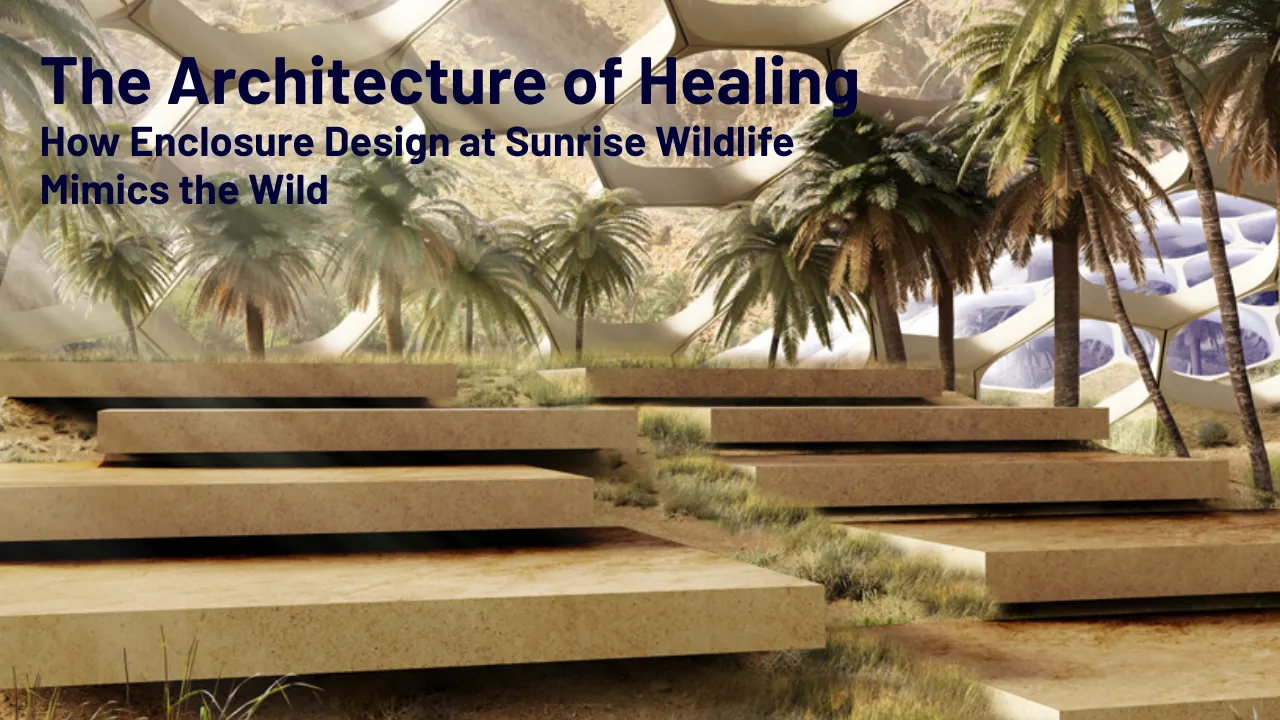Enclosure Design at Sunrise Wildlife: Enclosure Design at Sunrise Wildlife represents a transformative approach to animal care and rehabilitation. It’s not just about giving rescued wildlife a place to rest—it’s about offering a natural, familiar space that supports recovery, encourages instinctual behavior, and restores balance. These enclosures are more than cages; they are purposefully built ecosystems that nurture the physical and psychological well-being of each animal.
This article offers an in-depth look at how Enclosure Design at Sunrise Wildlife is shaping the future of ethical wildlife care. It examines how natural materials, water features, and strategic layouts support instinct-driven behavior and reduce stress. We’ll explore how Sunrise Wildlife crafts environments that heal, enrich, and prepare animals for a return to their natural world.
Enclosure Design at Sunrise Wildlife
At the heart of Sunrise Wildlife’s mission is a belief that healing begins with the right surroundings. The enclosure design at Sunrise Wildlife mimics the wild using local vegetation, natural land contours, and features that support behaviors like foraging, climbing, and hiding. These enclosures are structured to reduce anxiety and allow animals to reconnect with their natural instincts. From birds of prey to ground-dwelling mammals, each animal is given a customized space that nurtures both the body and mind. With the use of ethically sourced materials, behavioral research, and dedicated staff collaboration, Sunrise Wildlife is pioneering a new standard in animal rehabilitation enclosures.
Overview of Natural Design at Sunrise Wildlife
| Feature | Purpose | Example Elements |
| Natural Materials | Create familiar surroundings | Local rocks, native plants, wood logs |
| Water Features | Encourage natural hydration and behavior | Small ponds, streams, shallow pools |
| Hiding Spaces | Provide safety and stress reduction | Burrows, thickets, covered dens |
| Behavior-Focused Layout | Support movement and instincts | Flight zones, climbing areas, tunnels |
| Environmental Enrichment | Stimulate natural mental patterns | Scent trails, food puzzles, changing items |
Nature-Inspired Enclosures for Animal Well-being
At Sunrise Wildlife, every enclosure is designed with a singular purpose: mimic nature as closely as possible. Instead of sterile, artificial spaces, animals are given environments that resemble the forests, deserts, or wetlands they originate from. This includes planting native flora, replicating terrain patterns, and using real logs and stones that blend seamlessly with the landscape.
This design helps animals feel grounded and encourages instinctual behaviors like foraging, climbing, and nesting. When creatures are surrounded by familiar elements, they are less likely to exhibit stress behaviors and more likely to begin healing naturally. This approach also fosters readiness for reintroduction to the wild, since animals remain in touch with the habits and actions needed for survival.
Use of Local Materials for a Natural Feel
One of the most notable aspects of enclosure design at Sunrise Wildlife is the use of locally sourced materials. The design team avoids synthetic decor or plastic shelters. Instead, materials are gathered from nearby forests and natural reserves to ensure authenticity. This reduces the artificial feel of the enclosure and promotes biodiversity by supporting native insects, plants, and microorganisms.
Natural textures—like bark, soil, river rocks, and straw—play a big role in building trust with the animals. These elements not only look and smell familiar but also weather naturally, which allows the enclosures to evolve over time, just like the wilderness. This ever-changing environment keeps animals engaged and reduces boredom, especially in long-term rehabilitation cases.
Water Features That Do More Than Hydrate
Water is a life source in nature, and Sunrise Wildlife treats it as such in its enclosures. The facility includes custom-designed water features that are more than just hydration stations—they’re behavioral tools. Shallow pools encourage bathing and cooling down in warm climates, while streams offer hunting practice for aquatic birds or mammals.
These features are kept clean through natural filtration systems like gravel beds and aquatic plants, ensuring a low-stress environment that feels like a riverbank or wetland. Beyond functionality, the presence of flowing water adds calming ambient sounds that soothe the animals, especially those that have experienced trauma. It’s another way Sunrise Wildlife incorporates real-world cues into each healing space.
Hidden Spaces for Rest and Safety
Hiding spots are a cornerstone of enclosure design at Sunrise Wildlife, especially for prey animals or those prone to stress. Each enclosure includes strategic cover zones—whether it’s a dense patch of grass, a hollow log, or a rock overhang. These spaces offer a sense of control and privacy, which is vital for emotional regulation.
Animals choose when to rest or when to observe their surroundings, and this choice plays a huge role in rebuilding confidence. Even in shared enclosures or during limited public viewing, these hiding spots provide essential refuge. By creating physical and visual breaks within the enclosures, Sunrise Wildlife ensures animals feel secure at all times.
Encouraging Natural Behavior Through Space Planning
The design of each space is informed by species-specific behaviors. For instance, predators like bobcats have ambush zones and observation posts, while smaller mammals have tunnels and layers of vegetation for foraging. Birds have tree trunks and high perches to simulate flying and roosting patterns.
These behavior-driven zones are built into the layout from the start. The idea is to let animals act on their instincts without external prompts. This is especially helpful in preparing them for release, as it keeps their survival skills sharp. The enclosures are laid out in a way that promotes movement, curiosity, and natural interactions—key for both physical fitness and mental recovery.
Two Core Features That Support Healing
- Behavior-Based Design: Every animal gets an enclosure tailored to its species and individual needs. Nocturnal animals are given dim, quiet zones. Social species may share space with compatible animals to maintain social behavior.
- Stress-Reduction Elements: Natural sound barriers like thick shrubs, quiet zones, and visual buffers help block out human-made stressors. This encourages calm and stable daily routines for recovering animals.
Importance of Environmental Enrichment
Beyond space and shelter, animals at Sunrise Wildlife benefit from environmental enrichment, which plays a key role in cognitive healing. Enrichment activities include rotating scents, new climbing elements, and interactive feeding challenges. These practices break up routine and keep animals mentally sharp.
For example, a fox might be given a frozen food puzzle hidden in a pile of leaves, while a raccoon might have to unlock a natural bark box to reach its meal. These tasks stimulate thinking, curiosity, and motor skills, all while reflecting wild survival behaviors. The enrichment materials are biodegradable, safe, and aligned with each species’ habits.
Staff Collaboration in Design Process
The brilliance behind enclosure design at Sunrise Wildlife comes from the collaborative effort of diverse specialists. Wildlife veterinarians, animal behaviorists, landscape designers, and rescue staff all contribute to the enclosure planning. Before construction begins, thorough research is done on the species’ behavioral, social, and environmental needs.
This multi-disciplinary approach ensures no detail is overlooked—from how the wind flows through the space to how the sun hits certain spots at different times of day. It’s a dynamic, evolving process that continues long after an enclosure is first built, with regular adjustments made based on animal feedback and observed behavior.
The Result: A True Sanctuary
Ultimately, the enclosure design at Sunrise Wildlife results in more than just safe containment—it builds sanctuaries of recovery. These environments help animals regain their strength, confidence, and natural rhythm. Whether an eagle learning to fly again or a turtle recovering from injury, each creature is surrounded by tools to reconnect with the wild.
What makes Sunrise Wildlife unique isn’t just its compassion, but its commitment to realism and respect for the animal’s world. As a result, animals are healthier, calmer, and better prepared for reentry into their natural habitats. Visitors, too, walk away with a deeper respect for wildlife and a clearer picture of what ethical rehabilitation truly means.
FAQs
Why does Sunrise Wildlife use local materials for enclosures?
Local materials create a familiar, realistic habitat that helps animals feel safe and adjust more naturally during rehabilitation.
How do water features help animals heal?
They support hydration, bathing, and natural behaviors like fishing or cooling, reducing stress and encouraging physical recovery.
What kind of hiding spaces are used?
Natural elements like dense plants, logs, or rock caves are used to give animals places to retreat and feel protected.
Are the enclosures species-specific?
Yes, each enclosure is designed based on the unique needs and behaviors of the species it houses.
Is enrichment really necessary for wild animals?
Absolutely. It keeps animals mentally engaged, simulates challenges they’d face in the wild, and prevents depression or boredom during recovery.
Final Thought
Enclosure design at Sunrise Wildlife is setting a new benchmark in wildlife rehabilitation by creating healing spaces that are as close to the wild as possible. These aren’t just places to house animals—they’re carefully crafted sanctuaries where recovery happens naturally. With a deep respect for nature, intelligent design, and constant care, Sunrise Wildlife shows that the environment itself can be one of the best healers. If this inspired you, feel free to share, leave a comment, or explore more stories of how design meets compassion in wildlife care.












